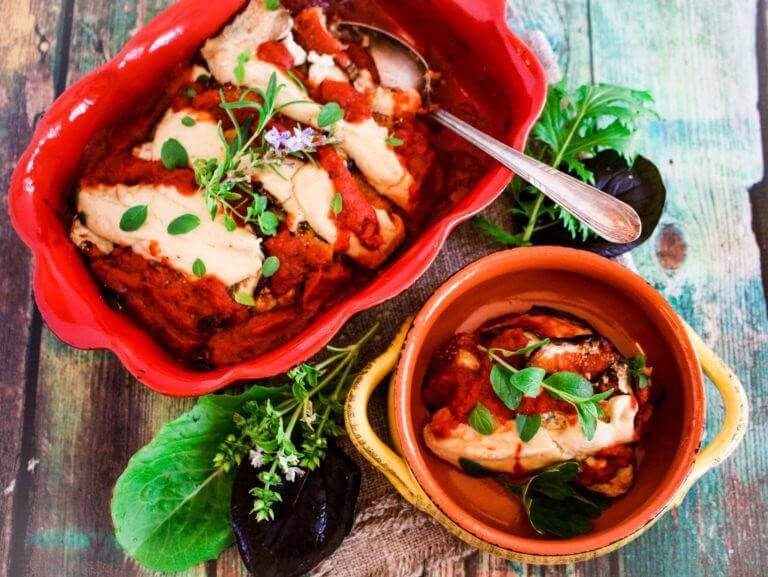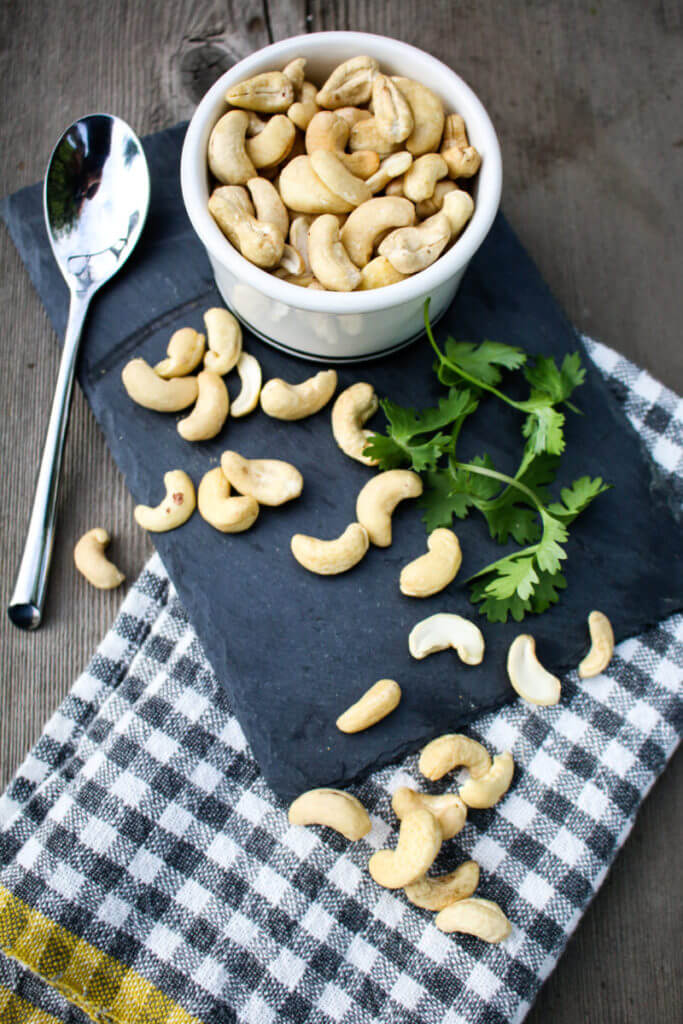Learn all about the health benefits of cashews, as well as how to cook with them with these top 5 tips on how to use cashews in the kitchen.
Cashews, though commonly referred to as nuts, are actually botanically considered seeds! These versatile, protein-packed sources of nutrients are originally native to Brazil, but are grown in warm climates around the world today. In fact, I’ve seen cashew trees growing in a few tropical locations I’ve visited (pictured below). Cashew trees produce fruits that are shaped like boxing gloves, and each of these fruits hold a single cashew nut inside a protective—and poisonous—outer shell. The cashews must be processed carefully and roasted or steamed before eating to avoid ingesting the outer shell. Interestingly, the shell’s toxin is related to urushiol, the allergenic oil found in poison ivy.

The cashew fruit, which is a reddish yellow color (shown above the cashew nut), can be eaten in a number of ways: fresh, cooked in curries, used to make jam, or fermented into vinegar and alcohol. It can also be used to make a sweet fruit drink that’s popular in Brazil and other cultures.
The cashew nut, the star of the show, is a tasty source of healthy fats, protein, and dietary minerals, including iron, copper, magnesium, and several B vitamins. One serving of cashews, which is about 18 nuts, or enough to fit in the palm of your hand, has only 157 calories and less than 9 grams of carbohydrates. One serving also provides 5 grams of protein, 12 grams of fat and 1 gram of fiber, which are both important for a healthy diet!
One study found that incorporating cashews into the diet decreased LDL (low-density lipoprotein), also known as “bad” cholesterol, and a different study found that eating cashews raised HDL, or “good” cholesterol. In all, cashews are not only a great source of macronutrients and micronutrients, but are also a tasty and heart-healthy snack.
Another great facet of cashews is their functionality and versatility in plant-based eating. They are essential in a plant-powered kitchen, because they can be whipped into creamy dairy replacements, as well as toasted into a variety of dishes that fit into every meal and category! Check out these Top 5 Ways to Use Cashews!

1. Mix into Your Trail Mix. Heading out on a hike or taking a long road trip? Try making trail mix with roasted cashews, dried fruit, and other nuts like almonds and peanuts. You can also add homemade granola for a taste of sweetness—this granola recipe has a delicious blend of pumpkin seeds, coconut, raisins, hazelnuts, blueberries, and lavender that would suit your cashew trail mix blend.

2. Make a Glass of Cashew Milk. Out of almond or soy milk, but need something for your cereal? To make cashew milk, all you need to do is soak some cashews overnight and blend them up! You’ll get a creamy, tasty beverage that’s perfect for coffee or cereal, or you can use it to make this spring-inspired herbal Lavender Chai Latte.

3. Whip up Some Cashew Parmesan! If pasta dishes are a staple in your house, you definitely should have a jar of shakeable Cashew Parmesan on hand. This recipe only has three ingredients (cashews, nutritional yeast, and salt) and takes only a few minutes to prepare. Best of all, it tastes just like shredded Parmesan, so you can sprinkle it on anything, from spaghetti to pizza!

4. Add to your Stir-Fry or Curry. Cashews are commonly used in Southeast Asian cuisines and can be blended into a curry or added directly to a stir-fry for a nutty, savory flavor. Try roasting them beforehand for even more of a crispy texture. They’re also a great protein source, so add them alongside tofu or tempeh in this stir-fry recipe for a protein-packed dish!

5. Blend up Cashew Cream. This versatile addition to your plant-based cooking routine just can’t be beat. Cashew cream can be added to savory dishes, such as lasagna, sauces, tacos, and salads, as well as desserts like puddings, tarts, and cakes. Learn how to make cashew cream in this step-by-step guide.

You’ll go nuts for these other recipes that include cashews:
Caramelized Cipollini Onions and Mushrooms with Pasta and Thyme Cashew Parmesan
Lentil Patties with Basil Arugula Cashew Cream
“Cheddar” Cashew Cheese
For other guides on how to use plant foods, check out the following:
Top 5 Ways to Use Sweet Potatoes
Top 5 Ways to Use Blackberries
Top 5 Ways to Use Avocados
Top 5 Ways to Use Romanesco
Written by Kathryn Atkinson, dietetic intern with Sharon Palmer, MSFS, RDN
Photos by Sharon Palmer, MSFS, RDN









